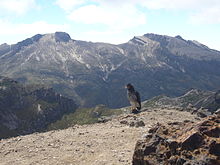Striped caracara
| Striped caracara | ||||||||||||
|---|---|---|---|---|---|---|---|---|---|---|---|---|

Striped caracaras ( Phalcoboenus carunculatus ) - gliding over a treeless plateau |
||||||||||||
| Systematics | ||||||||||||
|
||||||||||||
| Scientific name | ||||||||||||
| Phalcoboenus carunculatus | ||||||||||||
| Des Murs , 1853 |
The striped caracara (also Klunkerkarakara) ( Phalcoboenus carunculatus ) belongs to the subfamily of the vulture falcon in the falcon-like family . The species lives in the South American Andes of Colombia and Ecuador. The IUCN classifies the population as Least Concern .
features
The striped caracara reaches a body length of about 51–56 centimeters. The top shines black with bent-back cephalic feathers. The upper tail-coverts and a large spot at the end of the tail are white. Parts of the black underside are streaked with white, while the belly and the under tail-covers are completely white. In flight, the lower wing-coverts and the base of the flight feathers are white. The remaining black flight feathers are criss-crossed by closely spaced white spots. The birds have a dark brown iris. The wax skin, wrinkled face, and the upper part of the throat are reddish to orange-red, while the legs are light yellow. The beak is bluish-gray.
The plumage of growing birds differs significantly from adult specimens: young birds are yellow-brown to dark brown with a few white spots on the head and underside. The upper tail-coverts are whitish with a few brownish exceptions. In flight you can see a pale yellow-brown spot at the base of the hand wings. The bare head and legs are dark.
distribution and habitat

The birds are found in arid treeless areas of the high mountains, especially near grassy heaths and páramo vegetation. Here they move between 3000 and 4200 meters. In Colombia they occur in the central Andes of the Departamento del Cauca in the National Park of Puracé and south to the Andes of the Departamento de Nariño . In Ecuador, it is found in the provinces of Azuay , El Oro and the north of Loja . They are most often found in Ecuador in the ecological reserve of Antisana ( Reserva Ecológica Antisana ).
behavior
Individual animals and occasional couples stand out in their natural environment. Rarely do you see them in large numbers, unless they are near herds of cattle. The bird often strides on the ground and is therefore considered to be extremely lazy to fly. During their excursions on the ground they look for carrion, worms and insects, but also for seeds and other food. In flight, they like to be carried by the gusty mountain winds and are able to sail elegantly over longer distances. In general, they seem to take on the classic role of ravens and crows in northern latitudes.
Vocalizations
Striped caracaras rarely make a few harsh barking sounds.
Etymology and history of research
Marc Athanase Parfait Œillet Des Murs described the striped caracara under the name Phalcoboenus carunculatus , which is valid today . The type specimen comes from Colombia and was sent to him by the brothers Édouard and Jules Verreaux .
The word Phalcoboenus is a combination of the Greek words "phalkōn φάλκων " for "falcon" and "bainō βαίνω " for "to walk, run".
The word "carunculatus" comes from the Latin word "caruncula" for "small piece of meat".
The striped caracara is called matamico parameño in Spanish and is also known locally as curiquingue , matamico carunculado , caracara paramuno , caracara carunculado or caraca curiquingue .
literature
- Steven Leon Hilty , William Leroy Brown : A guide to the birds of Colombia . Princeton University Press, Princeton 1986, ISBN 0-691-08372-X ( books.google.de ).
- Robert Sterling Ridgely, Paul J. Greenfield: Birds of Ecuador Field Guide: Status, Distribution, and Taxonomy . tape 1 . Princeton University Press, Princeton 2001, ISBN 0-8014-8720-X (a).
- Robert Sterling Ridgely, Paul J. Greenfield: Birds of Ecuador Field Guide: Field Guide . tape 2 . Princeton University Press, Princeton 2001, ISBN 0-8014-8721-8 (b).
- James A. Jobling: Helm Dictionary of Scientific Bird Names . Christopher Helm, London 2010, ISBN 978-1-4081-2501-4 .
- Marc Athanase Parfait Œillet Des Murs: Description d'une nouvelle espèce de Phalcobène, Phalcobœnus carunculatus . In: Revue et magasin de zoologie pure et appliquée (= 2 ). tape 5 , 1853, pp. 154–155 ( biodiversitylibrary.org [accessed February 7, 2014]).
Web links
- Phalcoboenus carunculatus inthe IUCN 2013 Red List of Threatened Species . Listed by: BirdLife International, 2012. Retrieved January 29, 2014.
- BirdLife International: Species Factsheet - Carunculated Caracara ( Phalcoboenus carunculatus ) . Retrieved February 7, 2014.
- Videos, photos and sound recordings about Carunculated Caracara (Phalcoboenus carunculatus) in the Internet Bird Collection
- Striped caracara ( Phalcoboenus carunculatus ) at Avibase; Retrieved February 7, 2014.
- Phalcoboenus carunculatus in the Integrated Taxonomic Information System (ITIS). Retrieved February 7, 2014.
- xeno-canto: Sound recordings - Carunculated Caracara ( Phalcoboenus carunculatus )
- http://www.markuskappeler.ch/tex/texs2/karakara.html
Individual evidence
- ↑ a b c d Robert Sterling Ridgely u. a. (2001b) p. 102.
- ↑ a b c d Steven Leon Hilty u. a. P. 115.
- ↑ a b Robert Sterling Ridgely et al. a. (2001a) p. 178.
- ↑ Robert Sterling Ridgely et al. a. (2001a) p. 177.
- ↑ Marc Athanase Parfait Œillet Des Murs, p. 154.
- ↑ James A. Jobling p. 301.
- ↑ James A. Jobling p. 92.
